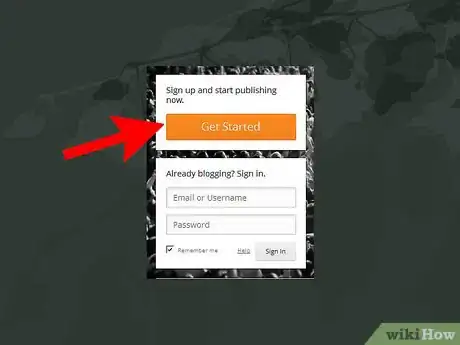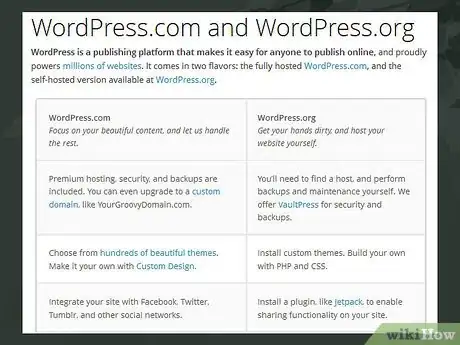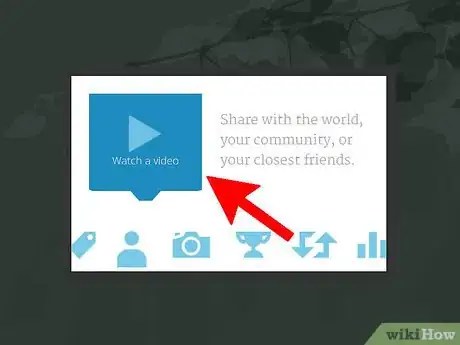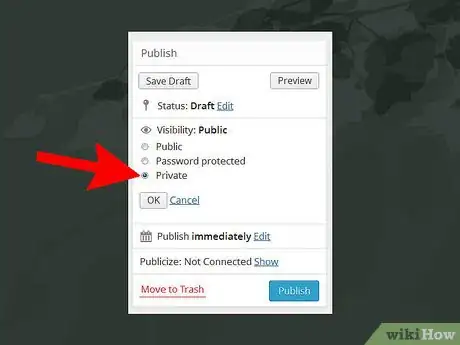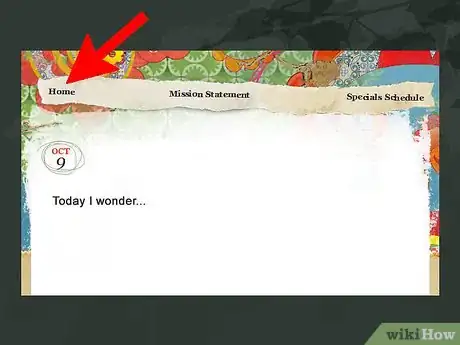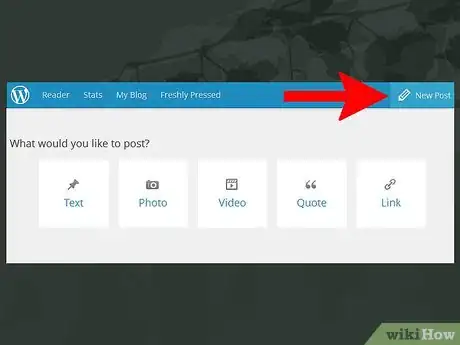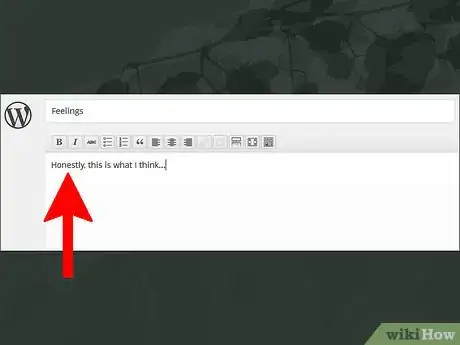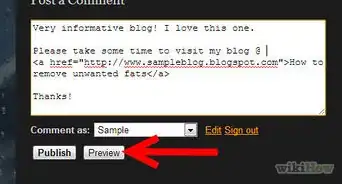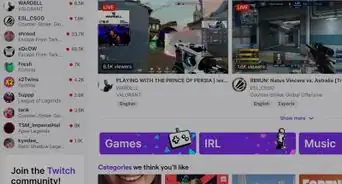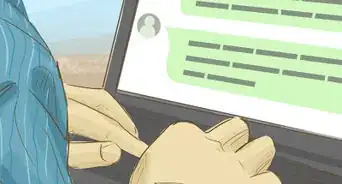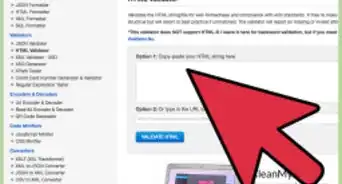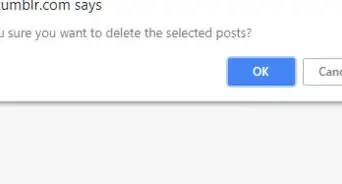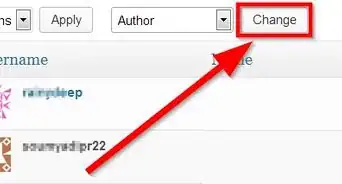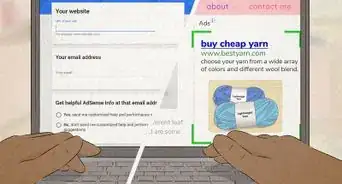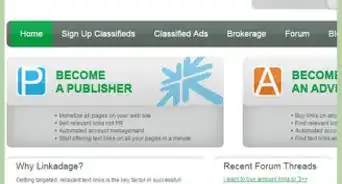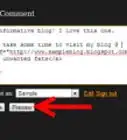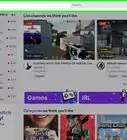Quickly and easily make a blog and start posting content
This article was co-authored by Maureen Taylor. Maureen Taylor is the CEO and Founder of SNP Communications, a leadership communications company based in the San Francisco Bay Area. She has been helping leaders, founders, and innovators in all sectors hone their messaging and delivery for almost 30 years, and has worked with leaders and teams at Google, Facebook, Airbnb, SAP, Salesforce, and Spotify.
The wikiHow Tech Team also followed the article's instructions and verified that they work.
This article has been viewed 715,836 times.
Trying to start your own blog? Blogging has become one of the more popular pastimes on the internet. Some people blog for money, others blog about current events, and others blog for humor. The list goes on. Increasingly, bloggers are using weblogs as a personal journal, preferring to keep it out of the spotlight. If you're someone who wants to start a personal blog, it's really quite easy. This wikiHow guide will show you how to create a personal blog.
Steps
Choosing Your Blog Platform
-
1Select a blog host. A host is a website whose blogging platform you'll use in order to start blogging. With the rise of the internet, dozens of blogging hosts have risen to prominence, many of them easy to use for people who know next to nothing about computers. There are plenty[1] [2] of free hosts in addition to hosts for which you need to pay. Here are a list of just a few:
- Free blog hosts:
- Wordpress.com
- Blogger
- Tumblr
- SimpleSite
- Wix.com
- Blog hosts with fees:
- GoDaddy
- Bluehost
- HostGator
- Hostmonster
- Free blog hosts:
-
2Determine how much control you want control over your URL. If you use a free blogging platform, your URL is going to look something like this:www.myblog.wordpress.com/
If you intend for your blog to be strictly personal, and you don't anticipate the need to build your own brand or start reaching out to other bloggers, a free web hosting service will do you fine. If, however, you believe that you may want to show your blog to other people and build your online presence at some point in the future, a paid hosting service will allow you to create a blog with a distinct and personalized URL In that case, your URL can look like thiswww.alittlebitofblog.com- Know the differences between free hosting services and paid hosting services. Mainly, paid hosting services offer much more control over the look of the website design, as well as offering more web tools with which to personalize blogs (plugins, widgets, buttons, etc.). Although the amateur blogger probably won't need a paid hosting service, it's useful to know what you can and can't do with a free platform:
- Generally, free hosting services offer a few basic pre-made templates for bloggers to choose from when designing the blog. Paid hosting services generally offer a greater variety of templates to choose from, as well as giving the blogger the option of designing the look of the website from the bottom up.
- The biggest misconception with Wordpress. Wordpress.com and Wordpress.org are different platforms that both provide the same purpose. They are both powered with Wordpress but with Wordpress.com your site will be hosted by the company vs. with Wordpress.org which you are hosting your self.
- Certain plugins are available only to people who pay for hosting services. A plugin is a tool that bloggers use to customize their blog. (A rotating tab, for example, is a cool plugin that allows viewers to see more of your content on tabbed panels.)[3] Countless other plugins exist for paid hosting services.
- This seems to be the bottom line: If you're just interested in creating a vehicle for your thoughts, these bells and whistles are probably superfluous. If, however, you take pride in the design of your website and like the idea of creating different tools for potential viewers to someday interact with, having more power to customize your weblog may be a good decision.
- Get familiar with the ins and outs of whatever hosting service you decide to use. How do you italicize a title? How will you create an outbound link to another website? These are questions that you'll ask yourself as you start blogging. Although your familiarity with your blogging platform will increase the more you blog, it's important to explore the different options you have with your blog. You often don't know what is possible until you try it.
- Some blogs offer an interactive video or slideshow to new users. If such a video or slideshow exists on your new blogging platform, be sure to watch it. These tutorials are packed with useful tips and hints, and will get you blogging faster and better.
Getting Started
-
1Design the look of your blog. Every time you log in to your blog, the design of it ideally should motivate you to write. For some people, a simple write background, mimicking a blank page, sets the heart aflutter. For others, an intricate houndstooth pattern does the trick. How do you want your blog to look?
- Choose a simple background over a loud and in-your-face one, although do what pleases you most. Here are some ideas for simple backgrounds you can mull over:
- A photograph of you and your family on vacation
- A simple, unobtrusive pattern that provides texture but doesn't take away from the words
- A map of picture of a map
- A writing object, such as a fountain pen, typewriter, or ream of paper
- A simple background in your favorite color
- Choose a simple background over a loud and in-your-face one, although do what pleases you most. Here are some ideas for simple backgrounds you can mull over:
-
2Look for a "keep private" check box within the options setting of your blog server. If you want your blog to be personal and de-indexed from search results, so that only you see it, check this option. In many blogs, there is also an option which allows you to keep your blog entirely private, where a password is required to access it. Look for this option if you want your blog to be truly secret.
-
3Design your blog for simple navigation. If you make categories into which you place your blog posts, try ordering the categories by popularity. Why put the blog post you visit least right up there at the top, and the blog post you visit most near the bottom? Design with simple navigation in mind.
- Reduce the clutter. Just because you have the option of creating dozens of plugins and widgets doesn't mean you need to use them. If this blog is indeed about you and your thoughts, make them stand out instead of extraneous stuff.
-
4Create your first blog post. In many public blogs, your first post is a short explanation of who you are (some secrets are kept) and why you decided to blog. It's an online introduction of sorts. Because you're building a personal blog, however, you need not be so formal in your first post.
- Write about what motivated you to start a blog. It may help to put things into writing. This is often a cathartic act, too, releasing certain tensions and stress. Try it on for size and see how it feels.
- Write about what you intended to write about. Jump right in. Your blog can turn into a diary of sorts, or it can be a place where you gather interesting articles from around the web and comment on them. Of course, it can be anything in between. Write or post about what makes you happy.
Maintaining Your Blog
-
1Try to blog every day. Even if nothing of note has transpired, it's important to set aside time to blog. Getting in the rhythm of blogging can be difficult, but pretty soon you'll be doing it by instinct: Like the first day of school, it may be a bit awkward at first, but you soon make friends and grow comfortable in your new environment.
- Think about special themed days when posting. If you wanted, for example, you could have "Maniac Mondays," where each Monday, you blog about one person whose crazy ideas changed the world. This lends your blog some structure and helps keep you writing, even when you're not exactly sure what to write about.
-
2Keep posts short. If you're having trouble writing, keep your blog posts short. A blog can be different from a diary, expose, or news article. It's meant to be digested quickly, to offer interlocking pieces of evidence and tie them together concisely. Keep these three guidelines in mind when you start blogging:
- A blog can be a place for reading. Jot things down quickly rather than write extended essays on them. A "Hey, look at this!" seems to be a lot more effective in blog form than a "And these are all the reasons why I'm better than you."
- Use links. Link out to other interesting pieces of content out on the web. For one, it will help you remember interesting sites that you stumble across. Second, it will save you the time to paraphrase what's going on — unless that's what you're trying to do!
- Revisit old themes. Just because you've already written a blog doesn't mean you need to file it away in a musty place. Revisit your feelings about that article in a new article, for example.
-
3Use first letters of names when writing about others to maintain anonymity. For example, "E made me very mad today; I've had it up to here with his selfishness." This ensures that no feelings will be hurt should someone stumble upon your blog.
-
4Be truthful.[4] Feelings do not always make sense! Fortunately, they don't have to. All that matters is that your emotions end up blogged rather than expressed as an ulcer. Remember that your blog exists only as an outlet for you. You don't have to worry about pleasing other people if you don't want to.
- Often, you'll find that writing about something helps you understand it. So even if you don't quite understand it yet, being truthful about it can help you figure it out. Writing is an act of self-discovery. If you're truthful when you write, you're sure to discover things about yourself that you didn't know about.
-
5Learn from your posts.[5] Once you have blogged for a while, go back and review. Have you learned the sources of stress in your life? Can you identify any running themes? Is a particular person toxic to your emotional health?
-
6Interact with your community of readers and commentors. Even if you are anonymous, your blog may still be enjoyed by readers and commentors. Often, they leave a comment underneath your article expressing praise, opinions, or questions. Successful bloggers understand that interacting with these fans of your work is an important part of spurring readership.[6]
- Respond to most, not all, comments. Often, a reader will leave a comment urging you to keep on writing. A simple "Thank you, appreciated," might be a good way to respond. Other times, people will ramble off-topic or express very controversial opinions. It is not necessary to respond to each and every one of your commenters if you don't wish to.[7]
- Include a call to action at the end of a post (optional). Obviously, if you don't intend to show your blog to other people, a call to action is unnecessary. But if you enjoy the thought of soliciting the opinion of your readers, include something like "What was your favorite Christmas present?" or "What do you think about the Federal stimulus?" in an appropriately themed post.
-
7Share your writing with close friends and family. The people closest to you care about your thoughts and feelings. Although you've probably started a personal blog as a placeholder for your own thoughts and emotions, it can be powerful to share those experiences with other people. What you're doing is starting a conversation, and conversation can be enlightening, uplifting, and powerful.
- For example, maybe you've just been given a diagnosis of cancer and decided to start a blog to document your journey. You only intended for it to be seen by you. But what you grew to understand as you started writing was that sharing your deepest fears and desires actually brought you closer to the people around you; it made you more human. Sharing this realization with your close friends and family can be incredibly freeing.
Sample Blog Post
Expert Q&A
Did you know you can get expert answers for this article?
Unlock expert answers by supporting wikiHow
-
QuestionWhat should I write my blog about?
 Maureen TaylorMaureen Taylor is the CEO and Founder of SNP Communications, a leadership communications company based in the San Francisco Bay Area. She has been helping leaders, founders, and innovators in all sectors hone their messaging and delivery for almost 30 years, and has worked with leaders and teams at Google, Facebook, Airbnb, SAP, Salesforce, and Spotify.
Maureen TaylorMaureen Taylor is the CEO and Founder of SNP Communications, a leadership communications company based in the San Francisco Bay Area. She has been helping leaders, founders, and innovators in all sectors hone their messaging and delivery for almost 30 years, and has worked with leaders and teams at Google, Facebook, Airbnb, SAP, Salesforce, and Spotify.
Communications Coach
-
QuestionHow do you retain readers?
 Maureen TaylorMaureen Taylor is the CEO and Founder of SNP Communications, a leadership communications company based in the San Francisco Bay Area. She has been helping leaders, founders, and innovators in all sectors hone their messaging and delivery for almost 30 years, and has worked with leaders and teams at Google, Facebook, Airbnb, SAP, Salesforce, and Spotify.
Maureen TaylorMaureen Taylor is the CEO and Founder of SNP Communications, a leadership communications company based in the San Francisco Bay Area. She has been helping leaders, founders, and innovators in all sectors hone their messaging and delivery for almost 30 years, and has worked with leaders and teams at Google, Facebook, Airbnb, SAP, Salesforce, and Spotify.
Communications Coach
-
QuestionHow can I make my blog stand out?
 Maureen TaylorMaureen Taylor is the CEO and Founder of SNP Communications, a leadership communications company based in the San Francisco Bay Area. She has been helping leaders, founders, and innovators in all sectors hone their messaging and delivery for almost 30 years, and has worked with leaders and teams at Google, Facebook, Airbnb, SAP, Salesforce, and Spotify.
Maureen TaylorMaureen Taylor is the CEO and Founder of SNP Communications, a leadership communications company based in the San Francisco Bay Area. She has been helping leaders, founders, and innovators in all sectors hone their messaging and delivery for almost 30 years, and has worked with leaders and teams at Google, Facebook, Airbnb, SAP, Salesforce, and Spotify.
Communications Coach
References
- ↑ http://www.pcmag.com/article2/0,2817,2388910,00.asp
- ↑ http://sixrevisions.com/tools/top-free-online-blogging/
- ↑ http://www.tripwiremagazine.com/2012/10/wordpress-widget-plugins.html
- ↑ Maureen Taylor. Communications Coach. Expert Interview. 6 March 2019.
- ↑ Maureen Taylor. Communications Coach. Expert Interview. 6 March 2019.
- ↑ Maureen Taylor. Communications Coach. Expert Interview. 6 March 2019.
- ↑ http://goinswriter.com/blog-comments/
About This Article
1. Select a blog host.
2. Decide whether to get a domain name.
3. Select a theme or design.
4. Create your first blog post.
5. Try to blog every day.
6. Use initials instead of names.
7. Interact with your readers and commenters.
